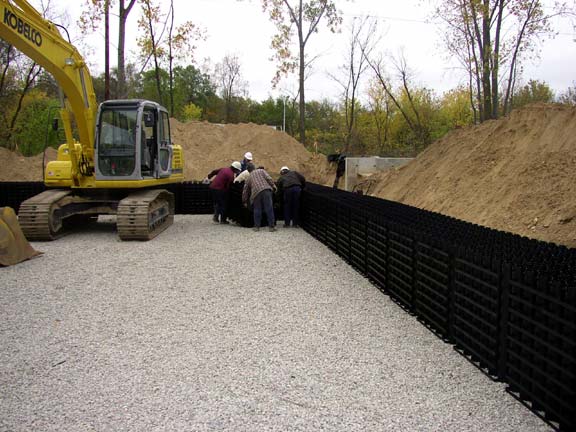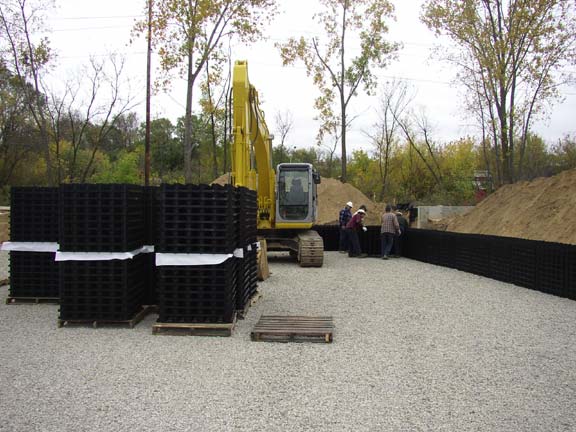Project Profile:
Grand Rapids Water Department LEED™ Certification
Project Summary
Designer Elaine Westhouse examined various options, including porous pavers, rain gardens, leaching basins, roof-top storm water storage, underground storm water storage in pipe, arched chambers and RS3. The final design incorporated porous pavers, leaching basins and trenches, a rain garden and underground storm water storage. RS3 would be used under the area that would become the main parking lot for the facility. “The RS3 product was chosen because the required storage volume could be contained in a smaller footprint than other products utilizing a higher vertical dimension,” Westhouse said. “RS3 provides greater volume capacity per square foot than pipe or arched chambers due to its geometry, and it does not require the drainage aggregate bedding that other systems require.” One challenge the design team encountered was that the RS3 system needed water entering the structure to be filtered. Excessive sediment could clog the geotextile filter fabric surrounding the structure, limiting the infiltration into the surrounding soil. Westhouse solved this problem by using two methods: incorporating a sediment/debris/oil filtration structure and allowing the storm water to drain across a grass swale to filter out sediments and oils. When the Grand Rapids Water/Environmental Services Facility project was completed, its environmentally friendly design and construction earned the facility the LEED certification and allowed Grand Rapids to become Michigan’s first city to receive this certification for one of its municipal buildings. Today, the Grand Rapids area is home to 11% of the LEED-certified buildings in the country. According to Fishbeck, Thompson, Carr & Huber, Inc. (FTC&H), the company responsible for assisting the city and its design team in pursuing LEED certification, the new facility features: • Energy savings through efficient building design; • Employee access to public transportation; • Employee bike storage and shower facilities; • Efficient storm water management systems; • Reduced light pollution; • Heating, ventilation and air-conditioning systems; • Recycling systems for office waste; • Use of building materials composed of recycled content including carpet, steel, ceiling tiles and insulation; • Sustainable design educational materials for visitors; and • Use of locally and regionally obtained materials. USGBC President, CEO and Founding Chairman Rick Fedrizzi presented the LEED certification to the city on Jan. 27, 2005. The presentation took place during a meeting of the Michigan Local Government Management Association, a gathering of city managers from across the state.
Address
1900 Oak industrial Drive, Grand Rapids, MI
Install Size
5634 units (563.4 m3)
Designer
WB Engineering, Elaine Westhouse P.E. 616-895-5503 [email protected]
Contractor
Van Drunen Excavating 7171 Wilson SW, Byron Center MI 49315
Project Gallery

Worker lift a cell stack into place.

The hydraulic excavator arm lifts cells around to the workers for final placement.

Stacks of nine high units sit on pallets in front of what will be a new Facilities for the Water Dept.
